Summer is in full swing, and we decided to make a selection of various "things" that you can do with your child in the summer:
1. Collect herbarium (leaves, flowers). And you can make a classic herbarium,
and you can also take a photo collection of all the flowers and plants that you saw over the summer.
2. Collect a collection of stones. To make the stones look better, it is better to store them in a container with water. And the brought stones can be signed and collected from different countries and cities
And flat pebbles can be beautifully painted
3. If there is a dacha, you can allocate a small garden for the child. Plant peas or carrots. Explain how to care. How then will it be great to eat what he grew himself
4. Arrange yourself berry days from time to time.
5. Study butterflies, all kinds of spider bugs, worms, snails and caterpillars. Make your own photo collection of insects. And small bugs can be viewed through a magnifying glass.
6. Observe the process of the appearance of tadpoles, and then watch how they gradually grow, they have legs, then the head of a frog, and finally the tail falls off and a small frog is already sitting in the hands
7. Watch the ants. And you can, as in childhood, stick a stick peeled from the bark and then lick the sourness from the ants.
8. See how a spider builds a web
9. Learn to determine the cardinal points in the forest (by mosses, anthills, etc.) without a compass
10. Look at drops of dew or rain on leaves or blades of grass.
11. With older children, study the constellations
12. Watch the sun rise and set
13. See how the flowers “fall asleep” (flowers close)
14. In the evenings, listen to how frogs croak, nightingales sing and grasshoppers chirp
15. Run in the warm summer rain, splash in the puddles, and then look at the rainbow.
16. If there is a village nearby, then there you can find chickens, cows, possibly sheep and goats. It will be very interesting for little ones to look at pets live, and not in pictures. And if you're lucky, you can see how a cow is milked and, finally, see with your own eyes where the milk comes from.
17. Listen to the cuckoo and count how many times it calls
18. Hang a feeder on the site and observe the birds in close proximity. You can record which birds came to feed. (in our country house - 80 km from Moscow, for many years bullfinches have been flying in and eating from our feeder. I have always been sure that the bullfinch is an exclusively winter bird, and in the summer they fly away somewhere. But for the last few years I I watch them all summer and autumn at my dacha)
19. Plant some flowers (for example, sunflowers) and watch how a sprout appears, then how it grows, how a bud appears, how a flower blooms
20. If there is a plot, then you can plant a tree with your child (for example, a Christmas tree or thuja) and it will be his tree. Or you can try planting an acorn or a chestnut and try to grow an oak or chestnut. But if the tree grows, in 20-30 years it will be really big and tall. And the child will be able to demonstrate to his children HIS own tree, which he planted in his childhood.
21. Find a stump in the forest and count the rings
22. Walk in the field and pick wildflowers. Weave wreaths of daisies or dandelions
23. Build a hut out of branches or make a treehouse (nail the boards - and you're done.)
24. Go hiking (water, hiking, mountain...) Or just spend the night in a tent, even on your own site next to the house
25. And you can go with a child a real one-day trip. On the way, boil water for tea on a fire (or burner), fry bread and sausages on a fire. Collect everything. What comes across interesting underfoot. For a small child, this will be a real BIG adventure.
26. Collect mushrooms and berries
27. Catch a fish
28. Keep a diary of a young naturalist (observe anything - birds, insects, plants)
29. Watch the birds hatch their chicks
30. Fly a kite and play other street games
Summer is the time for relaxation, summer fun, sun, beach. But even on vacation, you can give your child a lot of useful and informative information about nature. It's all around us.
We watch the sun.
Walking with the baby, show him the sun, tell him that it shines brightly, it has become very warm. Talk about seasonal clothing. Say that the sun heats up more, so the children do not dress warmly. Name summer clothes. What sun? (speech development) - yellow, warm, bright, light, affectionate. What does it do? Shines, warms, illuminates, etc. People wear sunglasses in summer. Talk for what. How else is summer different from other seasons? Everything is green, lots of flowers. Tell a poem about the sun.
Watching clouds.
On a cloudy day, watch the clouds with your child. What are they doing? They float, they move, they fly. What are they? Soft, fluffy, rainy. Tell the baby that they can move slowly, or they can move quickly (the wind is blowing). Sometimes the clouds cover the sun and it doesn't get so hot. Consider the clouds - what they look like, compose a fairy tale about the clouds. Sing the song "Clouds, white-maned horses" with the baby.
On an overcast day, watch the clouds. They are dark, thunderous, heavy. When the sky is covered with clouds, it indicates the approach of rain. Tell the baby about thunder and lightning.
Watching the wind.
On a windy day, look with your child at the swaying trees. Tell your child that it is the wind that is blowing. Watch how the grass and trees sway. Take a turntable and expose it to a gust of wind - it will spin. Tell your child about the wind in different seasons: an icy wind blows in winter. We come up with more epithets - cold, winter, etc. In summer - a warm, light, pleasant breeze. Invite the child to expose his face to the wind, close his eyes. The wind caresses the cheeks, the face. You too can blow like the wind. Take a feather, put it on the palm of your hand and invite the baby to blow. By the way, this is an excellent exercise for the development of speech.
Watching the rain.
Going outside when it rains, note that today the weather is rainy, rainy, cloudy. Look at the raindrops - they are large or small. Pay attention to the child that puddles are formed. You can throw pebbles into puddles, measure the depth with a stick, launch boats. Listen to the sounds of dripping rain. Watch the drops run down the windows. Tell the kid about how the rain waters all the plants and they grow. Compare dry ground and wet, dry asphalt is light and wet is dark. After the rain, everything is wet - both the earth and the leaves. Drops glitter in the sun. My son and I have this "Kapitoshki". We love to shake them off the trees, touch them with our fingers.
We are watching the storm.
Watch the storm and its approach. Before a thunderstorm, heavy clouds cover the sky, a strong gusty wind rises. The wind shakes the trees a lot. Everything around is gradually darkening. Birds fly screaming, trying to hide. Lightning flashes, thunder rumbles.
We watch the rainbow.
Tell your child that there is a rainbow after the rain. Tell about the colors of the rainbow, draw a rainbow with your baby. Pay attention to the crumbs that it gradually appears and gradually disappears.
We watch the trees.
When walking with a child, show him various trees, name them. Offer to touch the bark - it is rough (for tactile sensations). Tell us about how you change your appearance trees at different times of the year. Now they are green, they have a lot of leaves. Each tree has its own leaves, unlike the others. Look at coniferous trees. Spruce and pine do not have leaves, but needles. They are green in both summer and winter. Teach your child to take care of trees - they purify the air.
Watching flowers.
Consider flowers. Talk about their color, size. Invite the child to smell the flower. Describe the structure of a flower. Name flowers - chamomile, dandelion, peony, etc. Flowers are indoor, garden and field. Consider how they differ. Have the child guess.
Watching the water.
All children love to play with water. And that's great! not only develop the baby, but also relieve stress. Tell your child that water can be liquid and solid (ice). Water can have different temperatures: warm if heated in the sun or on the stove, cool if put in the refrigerator. What kind of water? Liquid, transparent, flowing. Determine which objects sink in water and which do not. Please note that in summer people swim in the sea. Why?
We observe animals and insects.
Introduce your baby to the animals you meet and insects. Tell us about where they live, what they eat. Watch the behavior of the animals. Pay attention to the appearance - some have wool, others have feathers. Some crawl, others fly, others walk.
It is impossible to list everything, but the main thing is to say and show the child everything that you see, hear and feel yourself.
Observations in nature with children in summer
Observation - purposeful systematic perception of objects and phenomena of the surrounding world. It's complicated cognitive activity, it involves perception, thinking and speech, requires sustained attention. By organizing observations in nature, the educator solves a number of tasks in a complex:
Forms knowledge of nature in children.
Learn to observe.
Develops observation.
Educates aesthetically.
In the summer, new opportunities open up for children to get acquainted with nature: many changes take place in nature. The time spent by children on the site is increasing, so it is necessary to think in advance about the activities of adults and children on a walk.
Observation preparation includes:
Determination of the place of observation,
The choice of the object of observation,
Preparing an object for observation
Preparation of everything necessary for observation.
Observations of wildlife.
1. Observations of plants.
The trees and shrubs have lush green foliage. children look at the leaves various trees, note that they are different in shape, size; distinguish and name bushes and trees. In meadows, in parks, gardens - a lot of different flowers. Meadow flowers: dandelion, St. John's wort, yarrow, clover, chamomile, tansy, bluebell. Garden: peony, phlox, gladiolus, nasturtium, rose, aster, dahlia. You can talk about the healing properties of familiar plants from which infusion, tea, syrup, oil, powder are obtained. Some medicinal herbs can be planted on the site by organizing a phyto-garden or phyto-bed. The ability to pay attention to the beauty of nature, the ability to see the beautiful, to admire it is being formed. Children learn to take care of plants, not to crush, not to tear them unnecessarily.
2. Animal observations.
Continue to work on familiarization with animals. To consolidate the ideas received by children in the spring. Animals take care of the cubs, teach them to get food, hide from enemies. An adult needs to explain to children that a responsible time is coming for birds and animals - nursing offspring. Children should know how animals behave, how they call their mom and dad. The younger ones imitate the movements and voice reactions of animals, the older ones list. Pupils should explain where homeless animals come from, why they are dangerous.
3. Birdwatching.
In summer, children continue to watch birds. Pay attention to how fast birds fly, catching insects, note how often they fly to the nest with food for chicks. The teacher tells that the birds feed their chicks with insects in the summer, thus helping to preserve the plants. You can suggest finding evidence of the usefulness of birds (look at the bark of trees). Examining the trees, children will meet with traces of the destructive work of bark beetles and woodcutters. The guys themselves will conclude: "If there are no birds, then the tree will die." It is necessary to warn preschoolers that birds' nests should not be touched, otherwise they will stop living in them.
4. Observations of insects.
P Many insects appear: a butterfly, a grasshopper, a bee, an ant, a fly, a beetle, a mosquito, a dragonfly. Butterfly, moth, admire them all together, examine the structure of their bodies with a magnifying glass. Give the concept of "fragile", a moth - "a living beautiful flower." While admiring butterflies with children, an adult can tell them why butterfly wings have different colors. It turns out that it helps insects hide from enemies. The green grasshopper is difficult to spot on the green grass, but it can be heard well from afar. Invite the children to listen to the chirping of the grasshopper, watch how it jumps and hides in the grass. Arouse in children a good attitude towards this harmless creature. Ladybug, beetle. When observing, use a magnifying glass. Consider cobweb legs, a crack on the back, wings. To form a desire to admire and protect living beings, not to harm them. In summer, children and adults are annoyed by unpleasant "neighbors" - flies, wasps. However, in nature there is nothing superfluous. Explain to the children that flies destroy rotting plant and animal remains, being orderlies. Wasps benefit by eating harmful insects, including houseflies. Needs to be developed in children careful attitude to insects.
Observations for inanimate nature.
1. Seasonal and weather phenomena.
The sun shines brightly. Rains are rare, warm, sometimes torrential, with lightning, thunder and hail. While observing the rain, children are led to understand the causes different nature precipitation in winter and summer, their dependence on air temperature. The teacher teaches children not to be afraid of a thunderstorm, but to be careful not to hide under tall trees during a thunderstorm. It is interesting to observe morning and evening dew, fog, to explain the reason for their formation. Associate seasonal conditions with lightweight children's clothing. Listening to poetry promotes colorful perception and brings children to the concept - summer is red. Show a bright seasonal phenomenon - a rainbow. On walks, they observe the height of the sun. AT senior group When determining the height of the sun, you can observe the shadow from objects, from the children themselves in the morning, when the sun has not yet risen high, and in the afternoon, when the sun is almost overhead, measure the length of the shadow. For observations, it is necessary to choose an open convenient place, stick a stick into the ground and observe the shadow cast by a vertically standing stick, illuminated by the sun. Children notice that the higher the sun rises, the shorter the shadow from the stick.
2. Water, sand, clay, pebbles, shells.
Given to children under the supervision of an adult. Ideas about the properties of these natural materials are refined, deepened and consolidated in the process of organized observations and independent activity children. The most relevant and favorite games in summer period are games with water and sand.
Time summer walks should be used to collect natural material that may be useful in free time in winter, in play activities. It can be herbs, flowers for a herbarium, pebbles, twigs, cones.
You can also organize work on the ecological trail. The main purpose of the ecological trail for preschoolers is not so much informational as activity-playing. No need to strive to make everything look perfect - remove dry leaves, destroy weeds. The ecological trail may contain - a vegetable garden, a pharmacy corner, a meteorological platform, alpine slides, flower "clocks".
Krapivnitskaya Oksana Nikolaevna, preschool teacher
The tour is designed for children of middle and older preschool age. The teacher takes it for a walk in the summer, but it can also be included as a fragment of a lesson on familiarization with the natural world.
Preliminary work: To fix the sequence of flowering plants in a flower bed from April to September, a herbarium is created together with the children (dried flowers are glued on a sheet of paper in the order they appear)
Target: to activate children's interest in the world around them, to systematize children's knowledge about a particular flower - chamomile.
Tasks: cause in children a positive emotional response to the beauty and diversity of the flower world;
To teach children to compare, find common and distinctive features of colors.
Develop thinking, observation, memory, the ability to draw conclusions.
To consolidate knowledge of the names of the summer months and colors.
preliminary work: work in the flower beds for sowing and caring for flowers, guessing riddles about flowers, looking at pictures of flowers, getting to know their name. Educator: Tell me, children, is it beautiful near the kindergarten? (children's answers)
- And what especially decorates the territory of the kindergarten now, in the summer? (children's answers)
- That's right, flowers. Let's take a tour of the territory of the kindergarten today and admire the beauty and diversity of the flower world.
What are the names of the places where flowers grow in our country?
- That's right, flower beds. Our kindergarten is decorated with beautiful flower beds with various flowers. Many flowers are familiar to you, I will tell you about some today.
Educator: Children, flowers are a symbol of happiness, kindness, beauty. Therefore, often, when you want to please a person, they give him flowers. So today I want to give you a gift. Admire them, take a closer look, you can even touch them, smell them, but do not pluck such beauty, and then we will reflect our impressions in the drawings.
(Children admire the flowers, some touch, examine, smell)
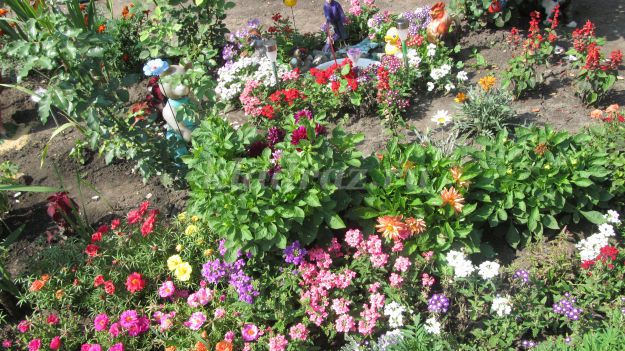
caregiver: What time of year is it?
name the summer months
What month is it?
And now name the flowers that bloom in the month of July. And a hint for you in our flower beds.
(rose, chamomile, marigold, calendula…)
Educator: Tell me, why do flowers bloom so beautifully in our flower beds? But in the forest, the flowers are not so large.
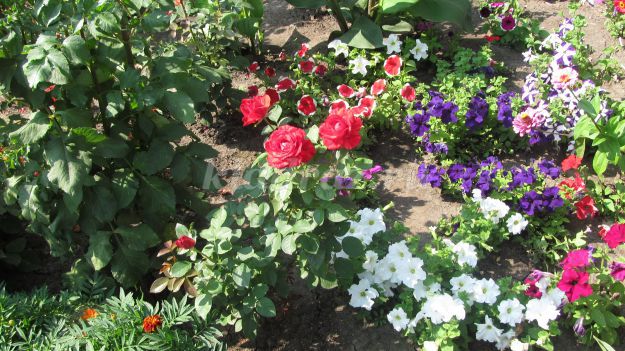
Children: they take care of the flowers in the flower beds, but not in the forest.
caregiver: Yes, that's right, in order for the flowers to be large, you can clearly see them in the flower bed, you need to take care of them. Let's remember how we did it.
Children: They dug the ground, sowed seeds or planted seedlings, watered when the ground was dry, loosened the soil, weeded from weeds.
Educator: Sisters are standing in the flowerbeds:
They have a golden eye
white eyelashes
What is this flower I asked you a riddle about?
Children: Chamomile.
![]()
Educator: Do we have chamomile in the flower bed?
Children pay attention to daisies
Educator: What does this flower look like?
Children: In the sun with rays
Educator: Yes, chamomile is always compared with a clear sun. In our country, chamomile is a symbol of purity and kindness. There are many types of chamomile in nature, but the most famous are odorless chamomile (shows) and pharmacy chamomile (shows). Daisy flowers have amazing healing properties. Decoctions and infusions from it are used in medicine.
Previously, this flower was called "romanov color", over time, people began to affectionately call it "chamomile". But in a scientific way this flower is called "nivyanik".
(Children repeat the name)
caregiver: Let's look at this little sun and talk about its structure.
Children: Tall straight stem covered with long green leaves. In the ground, the flower is held with the help of roots. The flower itself consists of many white petals and a yellow center.
Having smelled the flower, the children say that garden chamomile or daisy does not smell.
caregiver: Garden chamomile is an odorless plant, but it attracts insects with its color. Flying from one flower to another, flies, bees, butterflies and other insects carry pollen.
(The teacher draws the attention of children to echinacea and rudbeckia)
Children, look, we have more flowers growing in our flower beds that look like daisies. Can they also be called daisies?

Indeed, these flowers look like daisies, name what?
Children: Flowers also have many petals like chamomile, they have a middle, a high stem, long leaves.
caregiver: That's right, these flowers are similar, but what's the difference?
Children: These daisies (pointing to echinacea) have pink petals, and the middle is brown, but these (points to rudbeckia) have yellow petals, with brown spots to the middle, and the middle is also brown.
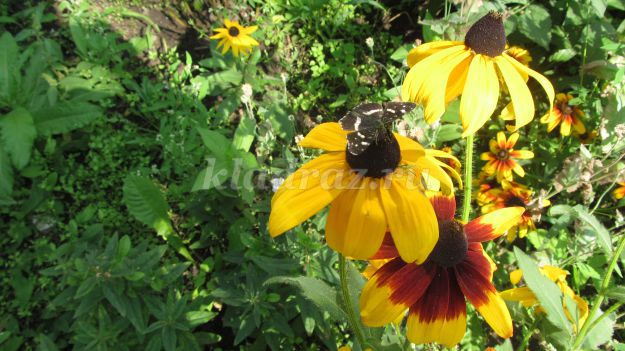
And they also differ in the shape of green leaves, and the trunks are hard, rough.
(children examine the stems of these plants by touch)
Educator: A plant with rose petals is called echinacea.
(Children repeat the name)
She, like chamomile, has healing properties and is also used in medicine. A sore throat - a decoction of echinacea will help, hurt your knee - wash the wound with the same decoction. It strengthens our body well if we use medicines and vitamins with this plant.
Educator: A plant with yellow petals is also called rudbeckia.
(Children repeat the name)
Educator: What is the name of the common garden chamomile?
Children: Nivyanik
Educator: Chamomile is a flower dear to the heart, kind, gentle, cordial, which adorns our life, gives joy and health to a person.
Little sun on my palm -
White daisy on a green stem
With a white rim, yellow hearts.
How many are in the meadow, how many are by the river...
Educator: Let's once again admire the beautiful decoration of our flower beds, an abundance of flowers. And I suggest you decorate the paved paths with flowers.
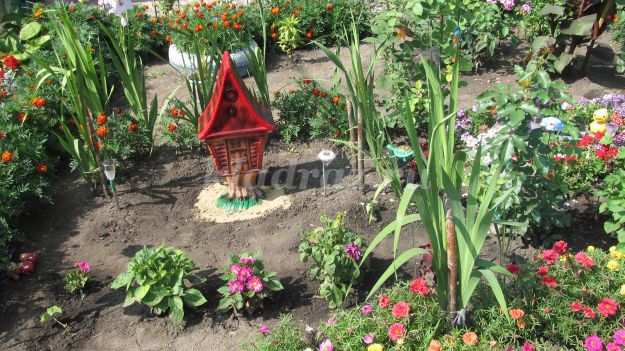
Draw on the pavement those flowers that you especially like and then our kindergarten will be full of flowers.
The teacher distributes colored crayons to the children. Children draw flowers on the pavement.
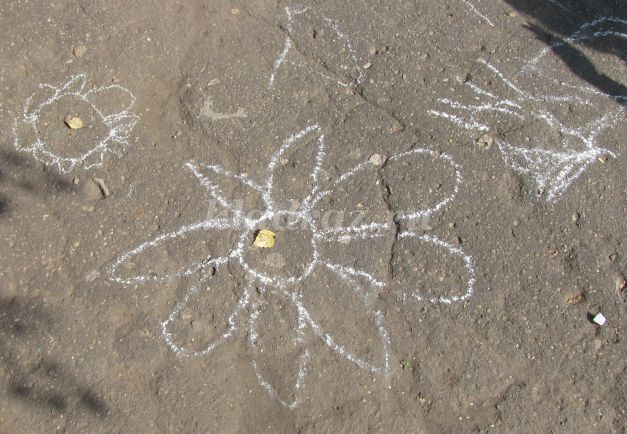
The soundtrack of children's songs will turn on.
Added on 06/18/2014
In order to see the first flowers or a frosted birch, it is not necessary to go to the forest, just look around, and you and your child will always find an object to observe. It is necessary to maintain a keen interest in nature in the baby.
Observations of animate and inanimate nature, natural seasonal changes develop memory, attentiveness, the ability to see beautiful things in children and bring up a careful and thoughtful attitude towards the world around them.
Autumn walks
Walking on the street, draw the child's attention to what has changed compared to the summer:
-
Tell your child: “Remember, it was hot and warm in the summer, but how is it now?”
Talk about summer and autumn clothes: “When it was hot in summer, we went around in T-shirts and shorts, but what do we wear now?”
- Explain why it has become colder (there are gray clouds in the sky, they prevent the sun from shining).
- When it rains, tell your child that the weather is "gloomy", there are clouds in the sky. Invite him to substitute his palm: "Do you feel how the raindrops are dripping" drip-drip-drip "?"
- Pay attention to the child that after rain there are puddles on the roads and rubber boots should be worn.
- Ask: What color are the leaves on the trees?
- Pay attention to the strong wind, it blows the leaves off the trees, resulting in leaf fall. During windy weather, you can play with the "turntable".
- Invite your child to listen to the birds singing. Can not hear. Many birds fly to warmer climes. Explain to the baby why they are forced to leave their homes (no food and cold). Show flocks of flying birds.
- Ask: “Do you see butterflies, bugs, flies?”. Something they don't have. Tell us that in autumn insects hide in the cracks of houses, under the bark of trees, under fallen leaves and sleep there until the arrival of spring.
- Talk about how animals prepare for winter: a squirrel stores mushrooms and nuts, a bear eats before hibernation, makes a lair for itself.
- In late autumn, going out on morning walk, pay attention to crumbs on frost and on puddles covered with a crust of ice.
-
Read to your child poems on the theme of autumn; for example, such: K. Balmont “Autumn”, A. Koltsov “The winds blow”, S. Mikhalkov “Vegetables”, M. Khodyakova “If the leaves turn yellow on the trees”, I. Vinokurov “Autumn is walking”, V. Stepanov “Autumn goes."
winter walks
During walks, pay attention to the baby on the following:
-
Pay attention to how cold it is outside - you need to wear very warm jackets, 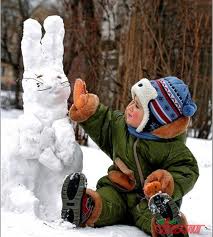 pants, hats, mittens, boots.
pants, hats, mittens, boots.
- Ask: “Can you see the sun in the sky? Does it warm? (the sun rarely shines, and if it does, it does not warm).
- Watch the falling snowflakes. Get them in your hand.
- Talk to your child about snow: what color is it? Where is the snow? (Everywhere: on roads, houses, cars - everything is covered in white snow).
- Tell your child that when the snow is sticky, it is good to make snowmen out of it, make snow figures when the snow is sticky.
- Remember the bear, which is now sleeping in a warm den under the snow. And the hare, the fox and the wolf do not sleep. They are hungry and cold. Tell them that in winter the hare's fur coat turns white so that it is difficult for wolves and foxes to notice him.
- Offer the baby: “Look, are there leaves on the trees?”. The trees are bare.
- Watch the snow-covered trees, choose which one is the most beautiful.
- Take your child to a pond: “Remember, in the summer there was water, and now there is solid ice.
- Pay attention to birds: crows, jackdaws, sparrows, pigeons, tits. They flock closer to human habitation. Make a feeder with your baby, put food in it and watch the arriving birds. What birds fly most often?
-
You can read the following verses about winter to your baby: A. Fet “A wonderful picture”, O. Vysotskaya “Winter has come with frosts”, I. Surikov “Winter has come”, I. Nikitin “Meeting winter”, E. Nilova “Winter is a miracle worker” , D. Popov “Spring has come”, A. Prokofiev “Winter-winter” and more.
spring walks
Walking on the street, pay attention to the child on the following points:
- Put your face together in the sun. Warm! The sun begins to shine brighter, it becomes warmer.
- Tell your child that it will soon be possible to wear light jackets, hats, walk without mittens, etc.
- Watch the icicles with your child. What are they? Long and short, thick and thin, transparent, hard, cold. The sun heats the icicles, and water begins to drip from them - “drip-drip-drip”, it turns out drops. Listen to these sounds.
- Watch how the snow melts, it becomes less and less, it turns into water, puddles, it becomes slushy on the roads. You can make grooves with a spatula so that water goes into them.
- Pay attention to the child how the buds swell on the trees, explain that leaves will soon appear from them. You can bring one branch home, put it in water and watch how the buds bloom and turn into castings.
- The child will be very pleased with the first flowers, in the city this is a coltsfoot. Examine them, talk about what color they are, how they smell, what kind of stem they have. (If possible, show the baby snowdrops).
- Listen with your baby to the cheerful chirping of birds. Show your child the rook, the first bird to return home from warm countries. Watch his important gait.
- Pay attention to the child that insects appear - butterflies, midges, mosquitoes.
- Tell the baby that a bear woke up in the forest after hibernation, that the hare's coat turned gray again, that the foxes had cubs, and the wolf cubs were born to the she-wolf.
-
Read poems about spring to your child: A. Pleshcheev “Country Song”, “Spring”, M. Sadovsky “Angry Snow”, S. Marshak “Snow is not the same anymore”, A. Leontiev “Drip-drip-drip”, I. Tokmakova “Spring is walking towards us”, F. Tyutchev “Winter is not angry for nothing” and so on.
Summer
During long summer walks, pay attention to the child on the following points:
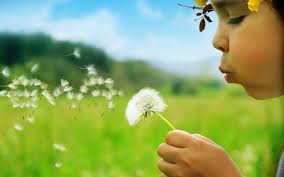 -
Talk about the fact that in summer the sun shines brightly and warms - it gets hot. Now you can walk in shorts and skirts and walk for a long time.
-
Talk about the fact that in summer the sun shines brightly and warms - it gets hot. Now you can walk in shorts and skirts and walk for a long time.
- Notice how the trees are green: "Look how many green leaves there are on the trees."
- Say: "There are many berries, fruits and vegetables in the summer." Recall with your child what he has already tried this summer. You can consider the assortment of vegetable counters of the store.
- Tell your child that in summer the birds hatch chicks, feed them with midges and worms, and teach them to fly.
- Note that there are a lot of insects in summer: butterflies, ladybugs, flies, mosquitoes, etc. Watch them. Note their size, color, distinctive features. For example, a ladybug has dots, a butterfly has four beautiful wings, and so on.
- In the summer, you will surely be able to see a rainbow at least once. Explain that a rainbow is made up of seven different colored arcs.
- Many flowers bloom in summer. Encourage your child to look at them, smell them.
- Read your child poems about summer. For example, such: L. Schmidt “What does summer smell like?”, A. Shibaev “what a good day”, V. Balashov “What is summer?”, Ya. Akim “Do you want to look at summer?”, I. Surikov “Bright the sun is shining".
Material for the lesson:
Tags: / / /